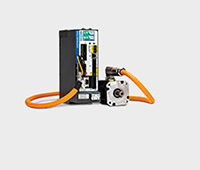 Movement disorders in the upper extremities are common among post-stroke patients. Some medical practices are turning to rehabilitation robots to help these patients.
Movement disorders in the upper extremities are common among post-stroke patients. Some medical practices are turning to rehabilitation robots to help these patients.
While rehabilitation robots are used clinically, much can be done to improve the designs and control algorithms of these robots. For example, one of the neglected aspects in the design and development of rehabilitation devices is the modeling of human interaction with the robot.
An emerging area of research is the use of musculoskeletal models to study human movement, making them an appropriate tool to interact with rehabilitation devices in simulations. In this project, Borna Ghannadi and Dr. John McPhee, researchers at the University of Waterloo, used MapleSim from Maplesoft to develop a musculoskeletal model of the human arm that provides the human action for an upper limb rehabilitation robot, to develop new model-based controllers for it. The controlled robot was tested in partnership with the Toronto Rehabilitation Institute (TRI) and Quanser.
The TRI/Quanser robot is an end-effector based planar robot that performs reaching movements in the horizontal plane for therapy of the shoulder and elbow. The team decided that a fitting starting point was to develop a simplified planar 2D musculoskeletal arm model that consists of two hinged links and six muscles and assumes no tendon compliance.
After evaluating tools from multiple vendors, the team selected MapleSim for their model development work. Said Dr. McPhee, “Taking into account simulation times and quality of results, MapleSim, because of its symbolic computation technology together with optimized code generation, performed better than the other software platforms.”
The team then developed an impedance controller, which can automatically adjust itself in a variable admittance environment, representing the variable levels of movement disorders affecting rehab patients. The controller was simulated running on the 2D model, in four different modes. The first two modes, simulating a healthy arm, were used to calibrate and tune the controller, while the second two modes, which simulated a post-stroke patient’s arm, were used to evaluate its performance.
Hand position error and muscle activation levels were measured and compared during simulation runs in the different operating modes. The results were positive, and in line with expectations, demonstrating that it is possible to use musculoskeletal arm models to evaluate the planar robot.
During the next phase of the project, the team will develop an advanced 3D musculoskeletal arm model with integrated muscle wrapping. As musculoskeletal models become more detailed and life-like, engineers are able to enhance the design of control algorithms for upper limb rehabilitation robots, which ultimately improves the rehabilitation process for post-stroke patients.
Maplesoft
www.maplesoft.com
Filed Under: The Robot Report, Medical-device manufacture, MOTION CONTROL, MORE INDUSTRIES





Tell Us What You Think!